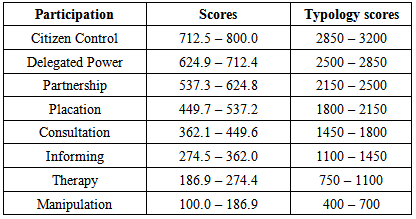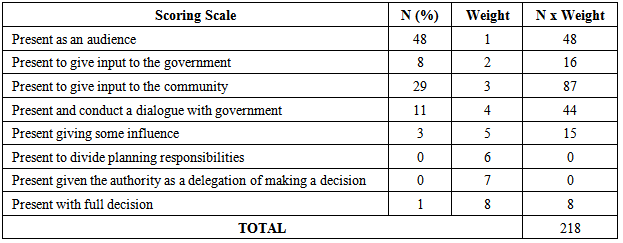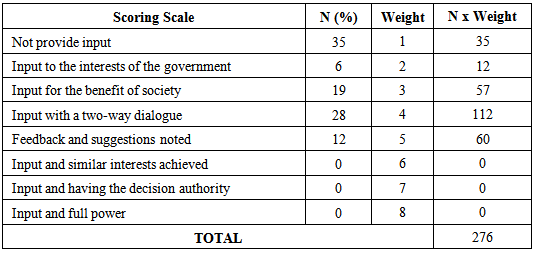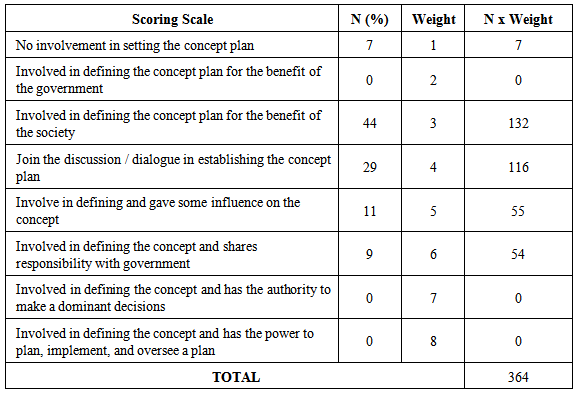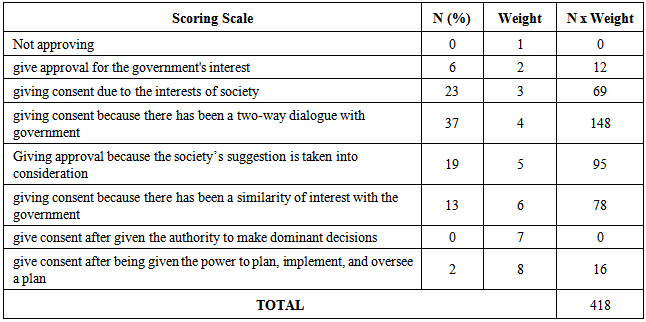-
Paper Information
- Previous Paper
- Paper Submission
-
Journal Information
- About This Journal
- Editorial Board
- Current Issue
- Archive
- Author Guidelines
- Contact Us
International Journal of Applied Sociology
p-ISSN: 2169-9704 e-ISSN: 2169-9739
2014; 4(3): 74-81
doi:10.5923/j.ijas.20140403.02
Public Participation towards the Formulation of Environment-friendly City Policy in Tulungagung
Heru Tjahjono1, 2, Mohammad Bisri3, Soemarno4, Eko Ganis5
1Environmental Sciences and Technology Graduate Program, University of Brawijaya, Malang, Indonesia
2Department of Fisheries and Marine of East Java, Indonesia
3Department of Water Resources Engineering, Faculty of Engineering, University of Brawijaya, Malang, Indonesia
4Department of Soil Science, Faculty of Agriculture, University of Brawijaya, Malang, Indonesia
5Department of Accounting, Faculty of Economics and Business, University of Brawijaya, Malang, Indonesia
Correspondence to: Heru Tjahjono, Environmental Sciences and Technology Graduate Program, University of Brawijaya, Malang, Indonesia.
| Email: |  |
Copyright © 2014 Scientific & Academic Publishing. All Rights Reserved.
The purpose of this study is to measure the level of public participation in formulation of environment-friendly city planning policy in Tulungagung, which is expected to be a consideration for the government in increasing public participation to this policy in the future. The results shows that the level of public participation in the environment-friendly city planning policy-making in Tulungagung according to the Arnstein typology is in the category of Information, which is included in the Degree of Tokenism, where the ruling authority creates an image and no longer hinders public participation. Tulungagung Government has provided information to the public about their rights, responsibilities and options, which is very crucial for initial step of public participation. Although practically the provision of information is came from the authority to the community, without any possibility to give feedback or negotiation from the society. In the current situation, especially the information given at the end of the planning, the public has less opportunity to influence the plan.
Keywords: Arnstein Ladder of Participation, Community Participation Level, Tokenism, Environment-friendly City
Cite this paper: Heru Tjahjono, Mohammad Bisri, Soemarno, Eko Ganis, Public Participation towards the Formulation of Environment-friendly City Policy in Tulungagung, International Journal of Applied Sociology, Vol. 4 No. 3, 2014, pp. 74-81. doi: 10.5923/j.ijas.20140403.02.
Article Outline
1. Introduction
- Global warming is an environmental issue that can lead to global climate change. Global climate change occurs slowly in a long period of time, about 50-100 years. Although it occurs slowly, climate change gives a huge impact on the lives of living beings. The impacts that occur include: ice melting in the South Pole, shifting seasons, and the rising of sea levels. These impacts effect the survival of living beings. Climate change that happens very quickly becomes the most important development challenges in this century. Based on the projections for 2005-2025, the urban population in Indonesia will increase from 53% to 67.5%. The rapid growth of urban population is followed by climate change that could pose a threat to the increase of temperature in Indonesia at the average of 0, 8℃ to 1℃ [1].The spread of uneven population density, plus uncontrolled population movements was feared to a buildup of various transport models will occurs that will lead to traffic paralysis. Traffic gets worse and evenly in every corner of the city. That requires an urban system that integrates the economics, business, government and environment in improving the life quality of residents by optimizing available resources. Good urban planning including the anticipation on the issue of global warming and climate change, as today’s demand. The cities that were not planned and managed with regard to global warming and climate change will lead to ecological and economic destruction [2].From the above conditions and the growth rate of development, in an effort to provide comfort and healthy environment for the citizens, then the concept of environment- friendly urban policy can be a solution on the basis of eco-friendly. Environment-friendly city is a concept that being proclaimed throughout the world so that each city contributes to the reduction of carbon emissions for global warming reduction. In addition, environment-friendly city is also a symbol of closeness to nature. The support of community participation will strengthen further and reinforce environment-friendly urban development. Characteristics and vulnerability of nature that coexists with the participation of the community is the basis of the concept of this development.In the development and application of environment-friendly city, the role of city government is very fundamental. As a self-regulating system, a city is made up of a control system (city government) and a homeostatic object (community or population). The city government will play a role as an institution that has legitimacy and responsible for the development and application of environment-friendly city through the policy-making process. Similarly with Indonesia, where the city has currently launched a program that is community-based eco-friendly, through the program of Green City Development Program (P2KH) where the implementation is contained in the Spatial Plan of the City and District. Development of environment-friendly city aims to improve quality and responsive to climate change which is currently an issue of the world [3].The success of development based on the arrangement of the city government policy which cannot be separated from community participation. According to Santosa and Heroepoetri [4], context of spatial planning has two types of basic requirement that needs public participation, i.e. control functions and information on social data. Public participation in spatial planning becomes important in terms of making a spatial planning as being responsive. A responsive planning by Mc. Connell (1981) in Santosa and Heroepoetri [4] is the decision-making process of spatial planning that is responsive to the preferences and needs of the communities which potentially affected if the plan is implemented. In order to achieve a responsive planning, the community involvement should be done since the beginning of the planning process itself. It is since the identification of problems, aspirations and also needed through the implementation phase of the spatial plan. With the community involvement process from the planning stage, utilization and control of space, a system of evaluation of spatial planning activities that have been carried out will appear and become an input for further spatial planning process.Participatory approach towards development is largely determined by the structure factor of socio-political, economic and cultural force in the local community [5]. Public participation in the development process of re-building process takes several references from developed countries [5-13]. However, the participatory approaches in the development process of developing countries do not seem to be considered in detail.Public participation is a widely promoted concept, but few governments have demonstrated their programs application correctly. In many countries, the community is involved most in one or several stages of the program cycle, such as the determination of development priorities, resource allocation, service management, project implementation and evaluation. There is a tendency for the government to involve community participation only to implement the decisions that have been passed by the elite or politicians. In most government programs, professional (political elite) dominate the decision-making process by degrading the non-professional or non-technical knowledge and skills of the community. The concept of community participation is strongly being misunderstood and sometimes equated with a sense of community involvement. In some cases, people participate passively. There is no common approach to translate people's participation in practice and this makes the debate about how and to what extent the community members must participate in the program [14].The effort in creating environment-friendly cities in East Java refers to the East Java Provincial Regulation No. 2 of 2006 on Spatial Planning and Regional Governance in East Java province, where in Article 1 Paragraph 34 is mentioned that an environment-friendly industrial activities, services and trade in the process of production or output priority method or technology that does not pollute the environment and is not harmful to living things. In realizing environment-friendly cities based on community participation refers to the lack of funding from the Regional Budget. The referral becomes a very strong base in integrating community participation as a major success of the carrying capacity of eco-friendly urban development [15].Therefore, this study will attempt to assess the level of Public Participation in the Formulation of eco-friendly Planning Policy in Tulungagung. The purpose of this study is to measure the level of public participation in policy formulation that structuring an environment-friendly city in Tulungagung. Thus, it is expected to a conclusion that could be used as a consideration for the government in increasing the public participation in the environment-friendly city policy-making in the future.
2. Research Method
- This study focuses on field research, to find out the problems and to obtain information and available data at the sites. In addition, this study also uses rationalistic paradigm, which emphasizes thinking in advance in the form of a concept or theory, as the basis for examining the symptoms that occur and perform an action. This research also supported by secondary data and review of literature. The use of the descriptive method is due to the focus on field research to obtain data or input from the community as the primary data. Quantitative descriptive method focuses more on interpretation of existing quantitative data contributing on the field. Otherwise, the qualitative description is focused on the disclosure of qualitative information through the data collection to be analyzed [16].
2.1. Research Site
- In accordance with the Tulungagung District Regulation No. 11 of 2012 on Tulungagung Spatial Planning 2012- 2032, the study was conducted in Tulungagung City on three districts, i.e. Tulungagung, Kedungwaru and part of Boyolangu District. Referencing to the implementation of spatial planning regulations, the environment- friendly city planning development will be centered on these three districts.
2.2. Data Collection
- Data were collected by using questionnaire to 100 respondents of citizens in the study sites. The respondents are community representatives who have been involved in the environment-friendly city policy-making, including the head of the urban and rural villages in the planning area of Tulungagung District, Kedungwaru District and Boyolangu District. The collection of qualitative data is obtained through interviews of key persons selected by purposive sampling, where each village would have taken three people (includes head of the village and secretary) who are considered to understand the development of the existing research areas and the potential of the study area [17].
2.3. Data Analysis
- Data were analyzed descriptively in qualitative and quantitative method. The level of participation is measured by quantitative method based on the total scores of all variables. The level of community participation was determined by the typology category of Eight Participation Ladder of Arnstein [18]. The magnitude of the interval score to determine the whole category level of community participation was based on the scores of individual participation level category multiplied by the number of samples. There are four criteria of questions with eight answer options to each question with score ranging 1-8. The minimum and maximum scores determined the distance of the interval score in the Arnstein Ladder (Table 1). According to Arnstein [18], there are eight levels of participation rate based on the strength of the community in the influencing the plan (Fig. 1). The overall community participation was also categorized in the typology of Arnstein (Table 1).
|
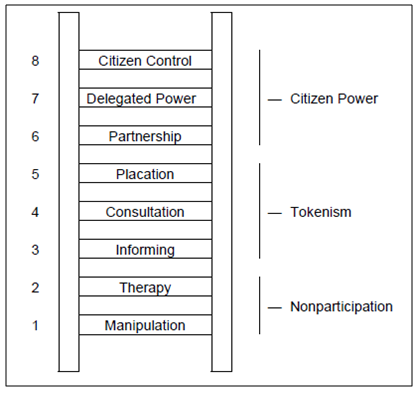 | Figure 1. Eight Participation Ladder of Arnstein (1969) |
3. Result and Discussion
- The level of public participation in environment-friendly city policy-making in Tulungagung is measured from the level of attendance at the meeting or conferences, activeness in giving input or suggestions or proposals, involvement in establishing the concept of the plan, and the involvement of approving the draft plan.
3.1. Attendance in Meetings and Conferences
- The total score on the variable of attendance in meetings/conferences is 218 (Table 2), which included in the level of community participation of Therapy, in the second Arnstein’s Eight Ladder. The participation rate is the second lowest, which under the guise of community participation in planning. In this level, experts treat community members such as the healing process of patients in therapy. Although people are involved in the activity, the activity is in fact get input from the public in the interest of the government.
|
3.2. Activeness in Giving Input, Advices, and Suggestions
- Most respondents do not provide feedback (35%) on the activeness in expressing input, advice, and suggestion (Table 3). It implied that the public continues to participate by attend the meetings which held by government of Tulungagung, but have no desire to participate in providing input, suggestions, or ideas. Brodie et al. [22] emphasized several factors that contribute to the active participation, i.e. the people’s understanding on the material of the meeting's, gender and social status in the community. Lowndes [23] showed that individuals from the community who are invited to participate can be a motivator if the government could provide a good and correct understanding. Bartle [24] referred to certain people as social animators; people who try to motivate and build the community into action through their knowledge on the existing network within the community.
|
3.3. Involvement in Setting up the Concept Plan
- Based on the concept of involvement in establishing the plan, the majority of respondents help to define the concept plan for the public interest as many as 44% (Table 4). It means that people who become representatives in the planning of environment-friendly city policy-making in Tulungagung already have a sense of responsibility in defining a concept. Similar participation case were occurred in Guatemala, a bottom-up structure based on the rights of all residents to be included in the decision-making process for policies that affect their daily lives [25]. Council at the level of society composed of community representatives, who act as leaders for the community and identify the needs and priorities of the communities they serve. The board members also participate in the formulation, planning implementation, monitoring, and evaluation of projects and policies that affect them or people in the community at the city level [25]. This level of Consultation is included in the Degree of Tokenism.
|
3.4. Involvement in Providing Approval of the Draft Plan
- Based on the involvement of approving the draft plan, all respondents gave consent. Most respondents give their approval because there has been a two-way dialogue with the government, for 37% (Table 5). It means that people in Tulungagung already aware the participation importance in the formulation of environment- friendly city planning policy, thus people would give approval to the draft plan that was made.
|
3.5. Overall Community Participation
- The level of public participation in environment-friendly city policy-making in Tulungagung can be determined by summing the scores of each variable as described previously, i.e. attendance in meetings and conferences; activeness in giving input, advice, suggestions; involvement in establishing the concept of the plan, and the involvement in approval of the draft plan (Table 6). The total score of public participation level in environment-friendly city planning policy-making in Tulungagung is 1276, thus the overall participation rate category is at Informing level.
|
4. Conclusions
- The level of public participation in planning the environment-friendly city policy-making in Tulungagung by Arnstein typology is in the category of Informing. It is included in the degree of Tokenism, where the ruling authority creates the image; no longer hinder the public participation. That means the government has been carrying out its obligations to provide information to the public by holding a meeting with some community leaders. Society acts only as recipients of information. Although there are inputs from the society, it will remain set as what has been planned or formulated by the government previously.
ACKNOWLEDGEMENTS
- The author would like to thank the Governor of East Java, Government of Tulungagung, Rector of Brawijaya University, Director of Graduate Program, Department of Fisheries and Marine Resources of East Java Province, the Society of Tulungagung District, Kedungwaru District, and Boyolangu District.
 Abstract
Abstract Reference
Reference Full-Text PDF
Full-Text PDF Full-text HTML
Full-text HTML